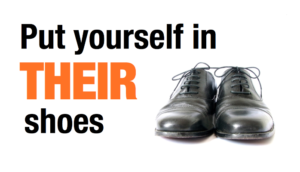 One time I created a webinar campaign for a client that had at least 28 separate “moving pieces” of copy…
One time I created a webinar campaign for a client that had at least 28 separate “moving pieces” of copy…
Emails, landing pages, order forms, etc., etc.
The campaign ended up generating over half a million dollars within a couple weeks, and getting thousands of new leads.
It was incredibly effective. And, we ended up running versions of that campaign over and over again for that client, and another affiliated company.
When I was putting that campaign together, I recognized something important.
At each stage in the process, each communication had a very specific function. That function was to take the customer from wherever they were at, to the next step in the campaign.
Each step was to do no more, and no less.
This requires very careful thinking. And execution. Because even one misstep could negatively impact the results of the entire campaign.
Doing this right requires you to put yourself in the shoes of the customer, and ask a handful of very important questions…
What do they already know about us, our market, our product or service, and the solution it provides?
What questions do they have right now that would really clarify the problem we solve, and a need for its solution?
What is an easy next step for them to take, to learn more about the problem/solution our product addresses?
What resistance or hesitation do they have to us, companies like ours, or products like the ones we offer?
What challenges have they had in the past in solving this problem?
What do they most want in the long run by solving the problem?
Are there any short-term questions, challenges, or desires that we can address right now to establish our value?
There’s a lot more I could probably go into. Especially in regards to the specific webinar campaign I’d created.
The important point is that you need to address these at many points in the process. The answers to these questions may change between an initial announcement email… An opt-in page… Emails to encourage webinar attendance… Attending the webinar… Finding out about your product or service… Getting follow-up communications… And so on…
The better you map your marketing to your prospect’s state of mind and current awareness, the more effective it’ll be…
Robert Collier was among the first to emphasize that your marketing must join the conversation already taking place in your customer’s head.
Eugene Schwartz’s biggest breakthrough in Breakthrough Advertising was all about creating marketing that meets your market’s current sophistication and understanding of your product and products like yours.
The most recent adaptation of this, Great Leads, by Mark Ford (as Michael Masterson) and John Forde talks about how to apply this when writing a big sales letter.
But it also matters on a very small level, too.
For example, you’re putting together a webinar campaign. You know you’ll eventually make an offer on the webinar. But your prospect doesn’t. Of course, you’re also going to deliver a ton of value in the webinar, too — and that’s what your prospect really wants.
The question then is: when you’re marketing the webinar to get prospects to sign up, do you tell them ahead of time that you’re going to make an offer? Do you even talk about your product — even in a way that doesn’t make it sound like you’re going to sell it?
(Hint: No, you don’t.)
You have to think all of this through, every step of the way. You have to consider every little interaction you’re having with your market, and put yourself in the prospect’s shoes. You have to ask what’s going to make your prospect most engaged with this message. You have to challenge yourself to give them exactly what THEY want, not what you want them to want.
I don’t know if there’s an easy way to do this…
There are some really tactical things you can do. For example, reading what your prospects read. Talking to prospects. Getting to know them. But also interviewing them, and probing them to start to understand their thinking.
And talk to people who aren’t your prospects. Travel. Engage in conversations with strangers. Talk to people from different social and socioeconomic circles than you normally run in.
But on a deeper level, you have to be able to step outside of yourself. Mindfulness and meditation practices help. Recognizing your perspective on the world, and that it’s one of over 7 billion human perspectives, and far more total perspectives if you start to count animals or other sentient beings.
You’ll get better at it as you get more experienced. Both because you know your market better, and because there really is something to be said for experience (both job-specific and general life experience).
Most importantly though, you have to be intentional.
Think about it. Ask yourself questions that require you to take on new perspectives.
Then, when it comes down to the nitty gritty of what to say, right now, look around. Look at what’s going to be happening in the prospect’s life, and around them right now, as they get your marketing. Imagine yourself in their shoes, sensing the world with all five senses. What’s going on emotionally? What are they thinking about?
What reaction is your marketing going to create based on that? What reaction should it create?
Get this right, and the world is your oyster.
Yours for bigger breakthroughs,
Roy Furr



